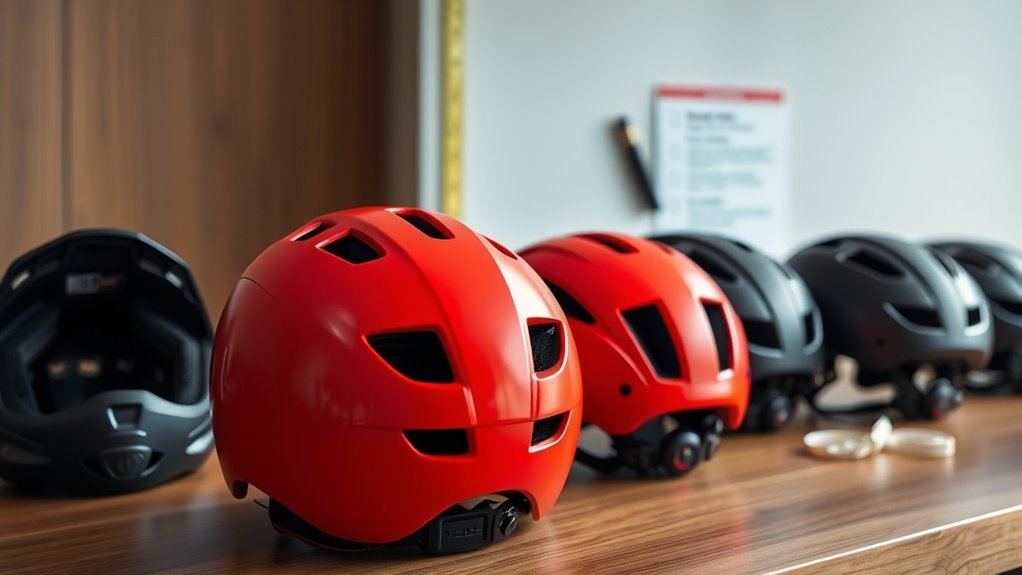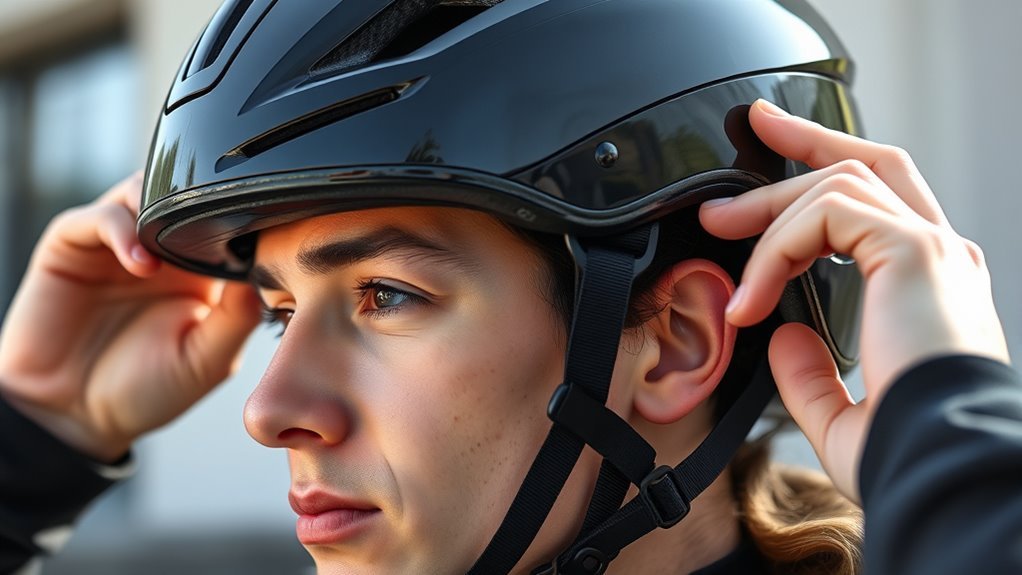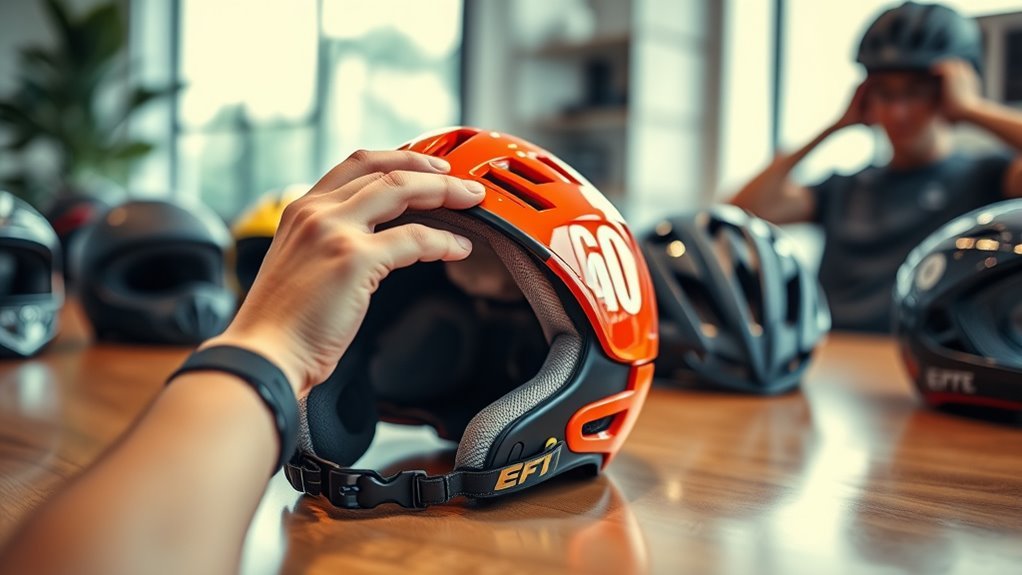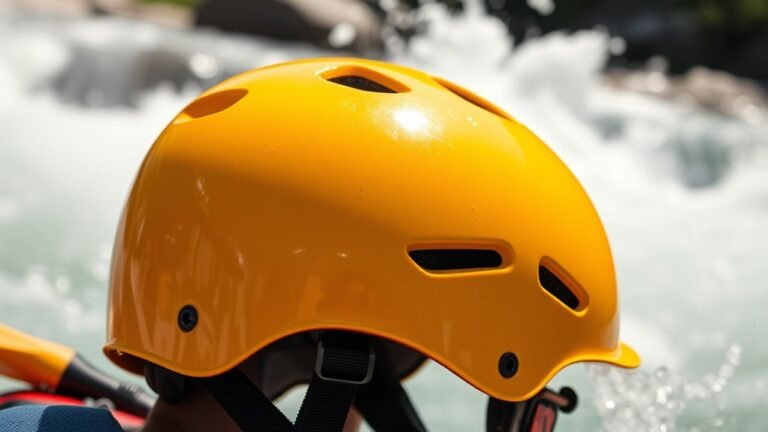How to Choose a Helmet for Proper Fit and Comfort
To choose a helmet for proper fit and comfort, start by measuring your head size with a soft measuring tape. Once you have your size, try on different helmets, considering your head shape; it should fit snugly without pressure points. Evaluate the padding material for comfort, and verify there’s good ventilation. Finally, check the retention system for a secure fit. There’s more to ideal helmet selection and care that can enhance your riding experience.
Understanding Helmet Types

When it comes to choosing a helmet, understanding the different types available is crucial for your safety and comfort. Full face helmets offer maximum protection, enclosing your entire head, face, and jaw. They’re ideal for high-speed riding or off-road adventures, providing a shield against wind, debris, and impacts. On the other hand, open face helmets provide more ventilation and a greater sense of freedom, exposing your face while still protecting the skull and back of the head. They’re well-suited for cruising and leisurely rides. Each type has its advantages, so consider your riding style and environment. Choosing the right helmet type not only enhances your comfort but also guarantees you ride with confidence and peace of mind.
Measuring Your Head Size

To measure your head size accurately, you’ll need a soft measuring tape or a piece of string and a ruler. Wrap the tape around the widest part of your head, just above your ears and eyebrows, ensuring it’s snug but not tight. Once you have the measurement, you’ll be able to determine your helmet size according to the manufacturer’s size chart.
Tools for Measurement
Accurate measurement of your head size is vital for finding a helmet that fits well and offers ideal protection. To achieve this, you’ll need effective measurement tools. A flexible measuring tape is the most common; wrap it around the widest part of your head, just above the ears and eyebrows. Make certain it’s snug but not too tight. If you don’t have a measuring tape, a piece of string can serve as an alternative; measure the length against a ruler afterward. Employing these measurement techniques guarantees you get precise data. Remember, it’s important to measure your head size when you’re relaxed, as tension can lead to inaccurate readings. Knowing your size enhances your freedom to choose a properly fitting helmet.
Finding Your Size
Finding your helmet size starts with properly measuring your head. Use a flexible measuring tape and wrap it around the widest part of your head, usually just above your eyebrows and ears. Note the measurement in centimeters or inches. This number will guide you in selecting the right size.
Keep in mind that head shape can affect fit, so be aware if you have a round, oval, or elongated shape. Many helmets offer fit adjustments through padding or internal mechanisms, allowing you to fine-tune comfort. Once you have your size, try on the helmet to verify it sits snugly without pressure points. Remember, a well-fitting helmet is essential for safety and freedom during your activities.
Selecting the Right Size

To select the right helmet size, start by measuring your head circumference accurately. Once you have your measurement, it’s essential to try the helmet on for fit and comfort before purchase. This guarantees the helmet provides adequate protection while remaining comfortable during use.
Measure Your Head Circumference
Measuring your head circumference is essential for selecting a helmet that fits properly and provides ideal protection. To guarantee accurate measurements, use a flexible measuring tape. Wrap it around the widest part of your head, just above your ears, and note the measurement. Keep in mind that head shape can affect fit, so consider how your head’s dimensions align with the helmet’s design.
| Head Size (cm) | Helmet Size | Common Fits |
|---|---|---|
| 51-54 | Small | Youth, Women |
| 55-58 | Medium | Most Adult Heads |
| 59-62 | Large | Larger Adult Heads |
Using these measurement techniques, you can confidently choose a helmet that combines safety with comfort.
Try Before You Buy
How can you guarantee a helmet fits properly? To guarantee ideal safety and comfort, you need to engage in helmet fitting. Start by trying on several models to find the one that feels right. When you put on a helmet, it should sit level on your head, snug but not too tight, with no gaps between your head and the padding. Perform comfort testing by moving your head side to side and up and down; the helmet should stay in place without causing discomfort. Don’t forget to check the chin strap for proper tension—your helmet should stay secure during movement. If it shifts or feels uncomfortable, keep searching until you find a helmet that meets your freedom and safety needs.
Evaluating Padding and Comfort
Padding plays an essential role in the overall comfort of a helmet, impacting both fit and performance during use. When evaluating padding, consider the materials used and how they influence comfort levels. Different padding materials can provide varying degrees of softness, moisture-wicking, and durability. Here’s a quick comparison:
| Padding Material | Comfort Level | Durability |
|---|---|---|
| Foam | Moderate | High |
| Gel | High | Moderate |
| Memory Foam | Very High | Low to Moderate |
Make sure to try on helmets with different padding types to find what feels best for you. A well-padded helmet not only enhances comfort but also contributes to a secure fit, allowing you to focus on your ride.
Importance of Ventilation
Ventilation is an essential aspect of helmet design that greatly affects comfort and safety during rides. When choosing a helmet, you should consider the various ventilation types available, such as fixed vents, adjustable vents, and internal channeling. Each type plays a vital role in enhancing airflow importance, which helps regulate your temperature, especially on long rides or in hot conditions. Proper airflow not only keeps you cool but also prevents sweat buildup that can lead to discomfort and distraction. A well-ventilated helmet guarantees you can maintain focus and enjoy your freedom on the road. So, prioritize ventilation to enhance your riding experience and make sure your helmet supports your performance, comfort, and overall safety.
Checking the Retention System
A secure retention system is essential for guaranteeing your helmet fits properly and stays in place during rides. Start by checking the retention adjustment mechanism; it should allow for easy tightening or loosening to accommodate your head shape. Make sure the straps are positioned correctly; they should form a V-shape under your ears. Adjust the strap placement to verify it’s snug but not overly tight, as discomfort can distract you while riding. Finally, perform a simple shake test—if the helmet shifts or feels loose, readjust until it fits securely. A well-fitted retention system not only enhances comfort but also maximizes safety, allowing you to enjoy the freedom of the ride without worry.
Testing the Fit
Once you’ve adjusted the retention system, it’s crucial to test the fit of your helmet to verify it’s both secure and comfortable. Proper fit adjustments guarantee that the helmet stays in place during your ride. Here are some key points to reflect on:
Testing your helmet’s fit is essential for safety and comfort—ensure it stays secure during your ride.
- Check for movement: The helmet shouldn’t shift markedly when you shake your head.
- Comfort level: Make sure there are no pressure points or discomfort.
- Forehead coverage: The helmet should sit just above your eyebrows.
- Chin strap: Confirm it’s snug but not overly tight, allowing for a finger’s width.
- Brand-specific fit: Different helmet brands may have unique sizing, so always refer to their fitting guidelines.
Test these aspects thoroughly before hitting the road for safety and confidence.
Maintenance and Care of Your Helmet
While your helmet is designed to withstand impacts, regular maintenance and care are essential to guarantee its longevity and effectiveness. Here are some key cleaning techniques and storage tips to follow:
| Task | Frequency | Method |
|---|---|---|
| Clean the exterior | After each use | Mild soap and water, soft cloth |
| Inspect padding | Monthly | Check for wear and tear |
| Store properly | Daily | Cool, dry place away from direct sunlight |
Frequently Asked Questions
How Often Should I Replace My Helmet?
You should replace your helmet every three to five years, even if it looks fine—think of it as a shield that can wear down over time. Watch for replacement indicators: cracks, dents, or any signs of impact. The helmet’s lifespan can diminish with exposure to sunlight and sweat, which can degrade materials. Trust your instincts; if it feels off or doesn’t fit snugly anymore, it’s time to invest in a new one.
Can I Wear a Beanie Under My Helmet?
Yes, you can wear a beanie under your helmet, but it depends on the beanie types and helmet compatibility. Confirm the beanie is thin and snug to avoid compromising the helmet’s fit. A thicker beanie could affect the safety performance, as a proper fit is essential for protection. Always verify that the helmet still sits securely on your head. Try different combinations to find what offers both warmth and safety without sacrificing comfort.
Are There Adjustable Helmets for Different Head Shapes?
Yes, there are adjustable helmets designed to accommodate different head shapes. These helmets feature adjustable sizing mechanisms, allowing you to customize the fit for maximum comfort. Look for models with dial systems or padding that can be moved or replaced, ensuring a snug fit that conforms to your unique head shape. This way, you can enjoy your activities without worrying about discomfort or safety, giving you the freedom to focus on the ride.
What Materials Are Helmets Made Of?
Think of a helmet as your personal fortress; it’s built from strong materials to protect you. Most helmets feature a polycarbonate shell, which offers durability and impact resistance, while the foam liner absorbs shock, cradling your head during an impact. When choosing your helmet, verify these materials are present for maximum safety. A well-constructed helmet not only shields you but also enhances your freedom to ride without fear.
Do Helmets Have Expiration Dates?
Yes, helmets do have expiration dates, typically ranging from 3 to 7 years, depending on the manufacturer. Over time, materials can degrade, affecting helmet safety. It’s essential to check the manufacturer’s guidelines for specific timelines. Regular helmet maintenance, like inspecting for cracks or wear, can also help guarantee your helmet remains effective. If your helmet’s past its expiration date or shows signs of damage, it’s time to replace it for maximum protection.






